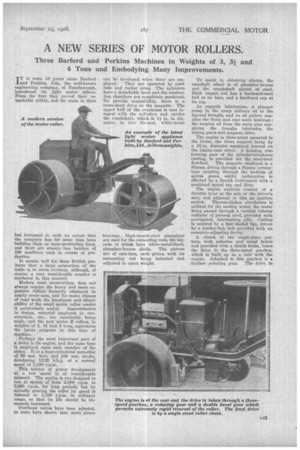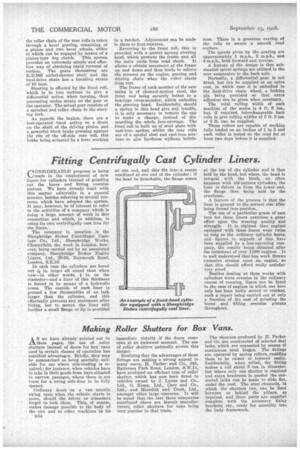A NEW SERIES OF MOTOR ROLLERS.
Page 27

Page 28

If you've noticed an error in this article please click here to report it so we can fix it.
Three Barford and Perkins Machines in Weights of 3, 31 and 4 Tons and Embodying Many Improvements.
ITT is some 18 years since Barford Perkins, Ltd„ the well-known engineering company, of Peterborough, introduced its light motor rollers. From the first they proved their remarkable utility, and the trade in them has increased to such an extent that the company has for some time been building them on mass-production lines, and there are always two batches of 100 machines each in course of production.
It speaks well for these British products that a large proportion of the trade is to users overseas, although, of course, a very considerable number is marketed in this coon trk.
Modern road construction does not always require the heavy and more expensive roller's 'formerly ethployed in nearly every case, and for many classes of road work the handiness and adaptability of the small niotor roller render
it particularly useful. Improvemehts in design, material employed in construction' etc., are constantly being made, and the new series B rollers, in weights of 3, ak and 4 tons, represents the latest progress in this type of machine.
Perhaps the most important part of a roller is its engine, and the same type is employed upon each member of the series. It is a four-cylinclered monobloc of 69 mm. bore and 100 rum.. strobe, developing 13.25 , b.h.p. at a normal speed of 1,100' r.p.m.
This matter of power development at a low speed is of considerable moment. The engine is one designed to ran' at speeds of from 2,000 r.p.m. to 8;000 r.p.m. for long periods, but by suitably gearing the roller its speed is reduced to 1,100 r.p.m. in ordinary usage so that its life should be immensely increased.
Overhead valves have been adopted, as tests have shown that more power
can be developed when these are employed. They are operated by push rods and rocker arms. The cylinders have a detachable head and the combustion chambers are completely machined. To provide accessibility, there is a cross-shaft drive to the magneto. The upper half of the crankcase is cast integral with the 'cylinders and carries the crankshaft, which is 1i in. in diameter, in two die-east, white-metal
bearings. High-tensile-steel stampings are used for the connecting rods, the bigends of whioh have white-metal-lined, phosphor-bronze shells. The pistons are of cast-iron, each piston with its connecting rod being balanced and adjusted to exact weight. To assist in obtaining silence, the camshaft wheel is of phosphor-bronze and the crankshaft pinion of steel. Each tappet rod ha a hardened-steel ball at its base, and a hardened cup at its top.
As regards lubrication, a plunger pump in the sump delivers oil to the big-end troughs, and an oil gallery supplies the front and rear main bearings; the surplus oil from the main pipe supplying the troughs lubricates the timing gears and magneto drive.
The engine is three-point mounted in the frame, the front support being by a 2i-in. diameter machined journal on the timing-case cover. A housing, also forming part of the cylinder-crankcase casting, is provided for the semi-steel flywheel. The magneto employed is a Simms, driven through a Simms verniertype coupling through the medium of spiral, gears, whilst carburation is effected by a Zenith instrument with a combined petrol tap and filter.
The engine controls consist of a throttle lever at the side of the driver's seat, and adjacent to this an ignition switch. Thermo-siphon circulation is utilized for the cooling water, the water ling passed through a vertical tubular radiator of pressed steel, provided with corrugated, intersecting gills. Cooling is assisted by a tour-bladed fan, driven by a leather-link belt provided with an eccentric-adjusting device.
A clutch of the single-plate pattern, with asbestos and metal fabric and provided with a clutch brake, takes the drive to the three-speed gearbox, which is built up as a unit with the engine. Attached to this gearbox is a further reducing gear. The drive to
the roller chain of the rear rolls is taken through a bevel gearing, consisting of a pinion and two bevel wheels, either of which can be engaged by means of a pinion-type dog clutch. This system provides an extremely simple and effective way of obtaining rapid reversal of motion. The gears themselves are K.E.805 nickel-chrome steel, and the final-drive chain has a breaking strain of 10 tons.
Steering is effected by the front roll, which is in two sections to give a differential action when turning, thus preventing undue strain on the gear or the operator. The actual gear consists of a sprocket and roller chain to the steering fork.
As regards the brakes, there are a foot-operated band acting on a drum on the shaft of the driving pinion and a powerful block brake pressing against the rim of the off-side rear roll, this brake being actuated by a lever working in a ratchet. Adjustment can be made in three to four minutes.
Reverting to the front roll, this is provided with a patent sprung steering head, which protects the frame and all the main units from road shock. It allows a certain movement of the frame up and down-and thus tends to relieve the stresses on the engine, gearing and driving chain when the roller starts from rest.
The frame of each member of the new series is of channel-section steel, the front end being securely bolted to a box-type cross-member, which embodies the steering head. Incidentally, should a spring in this head give any trouble, it is only necessary to remove the cap to make a change, instead of dismantling the whole fore-carriage. The front roll is built up of steel plate with cast-iron spokes, whilst the rear rolls are of a special steel and east-iron mixture to give hardness without brittle
ness. There is a generous overlap of the rolls to secure a smooth road surface.
The speeds given by the gearing are approximately 1 m.p.h., 2 m.p.h., and 4 m.p.h., both forward and reverse.
A feature of the design is that substantial spiral springs are utilized in the rear suspension to the back axle.
Normally, a differential gear is not fitted, but can be supplied at an extra cost, in which case it is embodied in the final-drive chain wheel, a locking pin being provided so that extra adhesion can be given when necessary.
The total rolling width of each machine of the series is 4 ft. 6 ins., but, if required, interchangeable back rolls to give rolling widths of 5 ft. 3 ins. or 6 ft. can be supplied.
These rollers are capable of working fully loaded on an incline of 1 in 5 and each roller is tested on the road for at least two days before it is supplied.
































